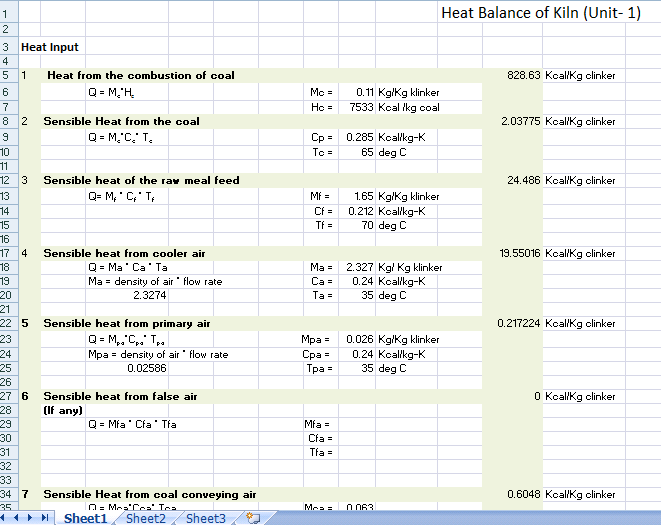Contents
click here to Download the Most Important 13 Books in Cement Industry
click here to Download the Most Important 13 Books in Cement Industry
Heat Balance of Kiln

I worked in more than 100 cement plant
the Below Figures is the average values , you can use it for bench-marking in your plant , please share in the Comments the figures in your plant even if you will keep the name of the plant as a secret
let’s begin
Heat Input
Heat from the combustion of coal

Sensible Heat from the coal

Sensible heat of the raw meal feed

Sensible heat from cooler air

Sensible heat from primary air

Sensible heat from false air

Sensible Heat from coal conveying air

Sensible heat from combustion

Sensible Heat from the moisture in the feed

TOTAL INPUT HEAT = 876 KCAL/KGCLINKER
Heat Output
Heat of Clinker reaction

Heat loss through the clinker at cooler outlet

Heat loss through the dust in the exhaust gas

Heat loss through evaporation of moisture

Heat loss from exhaust gases

From preheater exit

From Cooler outlet gases

Unaccounted losses

TOTAL OUTPUT = 876.103434 Kcal/Kg clinker
PLEASE SHARE YOUR RESULTS
Very nice to know about heat balance but Formula is not describe .so few difficult to solve it.
Please give me excel sheet in my mail
Please send me excel sheet for heat balance.
best regards,
please ,
do you maind not to send me the excel sheet
The manufacturing of concrete involves first blasting rocks such as limestone out from quarries, then transporting the rocks to mills, where they are further crushed and treated under high temperature through various processes resulting in the production of cement. Such energy-intensive processes create a significant environmental footprint; the production of traditional Portland cement accounts for about 5 percent of the world’s carbon dioxide emissions. To cut down on these emissions, Buyukozturk and others have been looking for sustainable additives and alternatives to cement. Volcanic ash has several sustainable advantages as an additive in manufacturing concrete: The rocky material, which lies in ample supply around active and inactive volcanoes around the world, is naturally available; it is typically considered a waste material, as people typically do not use it for any widespread purpose; some volcanic ashes have intrinsic, “pozzolonic” properties, meaning that, in powder form, the ash with a reduced amount of cement can naturally bind with water and other materials to form cement-like pastes. “Cement production takes a lot of energy because there are high temperatures involved, and it’s a multistage process,” says Chin, who with Kupwade-Patil led much of the group’s experimental work as a student in the Undergraduate Research Opportunities Program (UROP) with Buyukozturk.
Please give me excel sheet in my mail
Hi. Would you please send the excel to me?
Thanks.
May i ask you to send me excel sheet to
Tamertohamy@hotmail.com
Hi. Would you please send the excel to me?
Please give me excel sheet in my mail (saeedtanoli139@gmail.com)
Hello,
Have you tried to make a heat balance but instead of coals to calculate it for RDF? If yes, can You, please send me the calculations?
Please may you send me the excel spreadsheet to dennischaks@yahoo.com
Please may you send me the excel sheet to ch_bassam66@yaho.com
Very good and informative article. I congratulate and am eager to read and gain access to the information shared.
Thank you
Please send me in email
venki850@gmail.com
Pls send me via email tuannvan88@gmail.com. thanks you in advance.
Please send me in mail
Dear sir ,
please send me heat balance in EXCEL sheet.
thank you
with regards
sriniwas.M
Please send me excel sheet for heat balance.
best regards,
metehan.severoglu@gmail.com
Please, send me the excel sheet for heat-energy balance.
best regards,
metehan.severoglu@gmail.com
Dear sir ,
please send me heat balance in EXCEL sheet.
thank you
with regards
Please send me an excel file. Thank you in advance.
Dear sir ,
please send me heat balance in EXCEL sheet.
thank you
with regards
Raju
Dear sir ,
please send me heat balance in EXCEL sheet.
thank you
regards